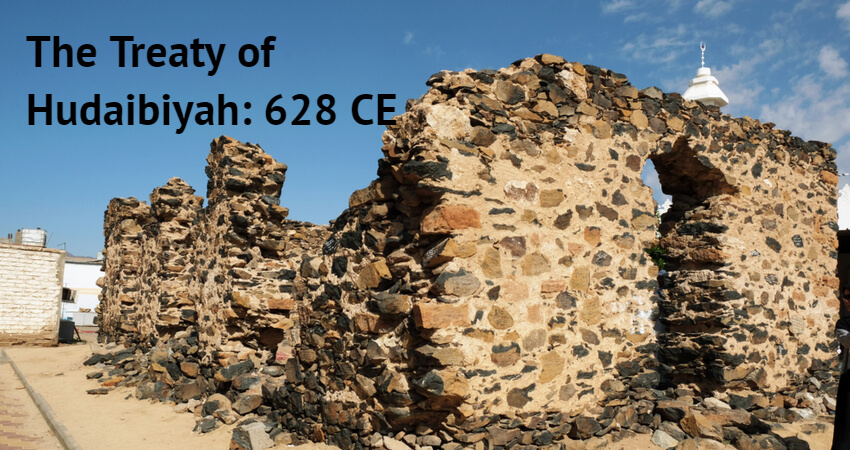A significant incident in the history of Islam, the treaty of Hudaibiyah was signed in the sixth year after Prophet Muhammad (PBUH) and his followers left Makkah. Despite their victory in the battle of Badr, the Muslims during that time were not strong enough to attack the Pagans of Makkah. But, they wished to visit the holy Kaaba and perform Tawaf.
It was then, the pivotal treaty between the Prophet and the Quraish tribe was signed. There were several benefits of the treaty of Hudaibiyah, including the decline in tension between the two factions, affirming peace. Moreover, it was as the result of the agreement Prophet Muhammad (PBUH) and his followers were allowed to enter Makkah the following year for what came to be known as the first pilgrimage.
History of the Treaty of Hudaibiyah
After leaving Makkah, Prophet Muhammad (PBUH) saw a dream that he performed Tawaf. Believing it to be a good sign, along with 1400 Muslims, he donned Ihram clothes and decided to visit Makkah. In the sacred state, the Muslims had their physical freedom restricted and were prohibited from fighting. They travelled without arms in hopes Quraish people would see their peaceful intentions to perform pilgrimage and allow them into the city as per customs.
However, this did not turn out to be the case as they were stopped outside the city. Later, Prophet Muhammad (PBUH) camped outside Makkah and had talks with the Meccan emissaries, who denied him entry. After long and peaceful discussions, the parties decided to resolve the matter through diplomacy and the points of the Treaty Hudaibiyah were drawn in January 628.
Hudaibiyah Treaty Conditions
The Treaty was a significant victory for the Muslims who wanted to peacefully perform the pilgrimage. After the Pagans of Makkah agreed to calmly resolve the situation, the conditions of the treaty were discussed at great length. The following points were decided then:
- Among the treaty of Hudaibiyah points, perhaps the most significant was that the Muslims will return to Madinah without visiting the Kaaba that year. Instead, next year, they will be allowed entry and a peaceful stay in Makkah for a period of three days.
- It was decided to hold a ceasefire between the parties for a period of 10 years. During this time, people were supposed to live in safety and harmony.
- It was decided that the agreement between any tribe and the Prophet was not prohibited. Similarly, anyone who wanted to join the Quraish people and sign an accord with them could not be stopped.
- One more vital treaty of Hudaibiyah point was that anyone from Makkah who entered Madinah will be returned to the Quraish people, but the people of Madinah wandering inside Makkah will not be extended the same courtesy.
Significance of the Treaty
The importance of the Treaty in the history of Islam cannot be denied. Even if some points of the treaty were not favouring Muslims, overall, the agreement was a good thing for the followers of Prophet Muhammad (PBUH). It is so because the treaty benefited the Muslims in several ways.
- Owing to the agreement, the hostile Quraish tribe recognised Prophet Muhammad (PBUH) as the leader of the state of Madinah.
- Since followers of Islam and the polytheists were no longer in an ongoing struggle, some people started seeing the religion in a new light and became its followers.
- After the agreement, Muslims were allowed to make alliances with other tribes.
- The 10-year armistice gave Muslims a chance to preach Islam and deal with the enemies on the other side of the peninsula.
Who Broke the Treaty?
The pilgrimage to the holy Kaaba is essential for Muslims; hence the treaty played an important role in the life of every individual. It allowed the Muslims to peacefully conduct the pilgrimage and become one with Allah. Further, the treaty was significant in stopping the long struggles of Muslims to visit the holy land and city of Makkah. In 630, right after two years when the treaty of Hudaibiyah was drawn, one of the clauses was violated. It so happened that Banu Khuza’s tribe, who was an ally of the Muslims, and Banu Bakr, who was with the Quraish people, clashed in a fight. During the battle between the two in 8/629-630, some members of the former tribe were slain by the latter group. In this way, a vital clause of the treaty was breached. Afterwards, the Quraish people went to Prophet Muhammad (PBUH) to apologise to him with Abu Sufyan, but they were not pardoned by him.
Key Lessons
The Treaty not only occupies a crucial place in the history of Islam, but also in the present times, it holds a significant value. The treaty offers several vital lessons to Muslims on patience and gentleness. Following are the lessons one can learn from it:
- Patience can resolve every problem: It is a difficult virtue to attain, but it has the power to resolve every issue. Although at the start, the conditions of the Treaty did not favour Muslims, but because Prophet Muhammad (PBUH) showed patience, peace was ensured.
- Raising your sword is not always the answer: Prophet Muhammad (PBUH) had the support of so many brave Muslim brothers. Still, instead of raising his sword despite the challenges, he chose to settle things through peaceful talks. Thus, the Treaty of Hudaibiyah points out that walking on the path of peace is vital.
- Muslims should honour agreements: From the treaty that was made in January 628, the Muslims should learn the value of commitments. Because the Quraish people did not follow the agreement and violated a vital clause, the Prophet invaded and defeated them by the grace of Allah.
The Treaty of Hudaibiyah aided in maintaining peace between the states of Makkah and Madinah. It ensured Muslims a chance to go on a peaceful pilgrimage to the holy Kaaba and allowed the formation of allies. For the true followers of Islam, it noted down and offered vital lessons on peace, patience, and victory.
Treaty of Hudaibiyah FAQs
How did the treaty of Hudaibiyah lead to the conquest of Makkah?
The treaty worked out as a prelude to the conquest of Makkah. When the Quraish people violated a vital clause of the treaty, Prophet Muhammad (PBUH) decided to not forgive them, which lead to the seizure of the city.
Who was responsible for scribing the treaty of Hudaibiyah?
The peace agreement between the parties was scribed by Muhammad Uthman Ibn Affan.
In what language was the treaty of Hudaibiyah written?
The Treaty of Hudaibiyah that was signed in January 628 was written down in Arabic.
Who were the negotiators of the treaty?
The treaty of Hudaibiyah that was signed to ensure peace between Madinah and Makkah was negotiated between the Prophet and Uthman Ibn Affan.
How long did the treaty last?
The conditions of the treaty of Hudaibiyah were drawn in January 628 and the clause was breached in 630. So, the treaty lasted two years.
What are the key lessons from the Treaty of Hudaibiyah?
One should remain patient, avoid quarrels, and honor agreements are some of the key learnings from the treaty.
Why was the treaty of Hudaibiyah signed?
Muslims wished to travel to Makkah and perform the holy pilgrimage but were not strong enough to attack Arabic tribes; hence, they signed the treaty with Pagans.







